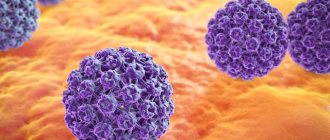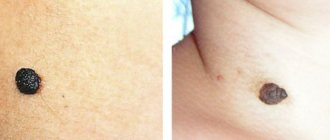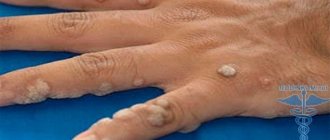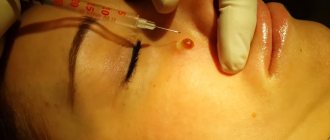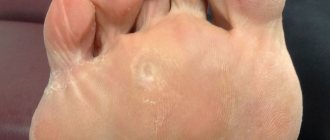Papilloma is a skin growth, the development of which is provoked by the human papilloma virus. As a rule, the nature of such formation is benign. However, at any moment, under the influence of any factors, this small tumor can transform into a manifestation of oncology.
That is why any change in the type of growth should alert the person on whose skin these growths appeared. And if the papilloma turns black, this may indicate the development of various processes in the neoplasm. What are these processes, what are their consequences, and can they be dangerous to humans?
Is it dangerous to change the appearance of papilloma?
The human papillomavirus provokes the appearance of new growths on the skin. They differ in size, shape, color. Dermatologists note that growths located in places of constant injury must be under constant supervision.
In some cases, they should be removed to eliminate the risk of negative consequences.
A change in appearance is one of the signs of the onset of the development of a pathological process. Additionally, a person experiences other characteristic signs of infection:
- sudden change in color: may turn black or blue;
- active expansion of education;
- a constant feeling of discomfort in the affected area, even at rest;
- emerging pain of a pulsating nature;
- purulent, sanguineous discharge from papilloma;
- putrid smell.
Each of the symptoms is a warning sign. Self-medication is prohibited. Concerns home remedies of traditional medicine, burning with celandine. It can cause warts to become infected and contribute to the development of the inflammatory process.
What to do
If the papilloma has gradually dried out and fallen off, then first of all the damaged area should be treated with an antiseptic solution, for example, Chlorhexidine. This is necessary to avoid infection getting into microcracks.
If the papilloma has not completely fallen off and some of it remains on the skin, then under no circumstances should you tear it off; the area should also be treated with an antiseptic and see a specialist as soon as possible.
If the growth has dried and fallen off, but a bleeding wound remains in its place, a bandage or cotton wool with a plaster soaked in hydrogen peroxide should be applied to the damaged area. It is important to keep in mind that in such cases it is not always possible to quickly stop the bleeding.
Tearing off a growth most often does not pose a serious threat to health; the main thing is to immediately disinfect it. But visiting a doctor is a prerequisite for this problem, since only he will be able to determine whether the root of the papilloma remains in the skin and prescribe competent drug treatment.
The difference between a darkened mole and papilloma
It is difficult for a non-specialist to find the differences between a papilloma and a mole. There are several signs that allow you to determine the type of education yourself.
| Papilloma | Mole | |
| 1. | It is distinguished by its looseness and soft structure. | Dense and hard. |
| 2. | Consists of connective tissue covered by skin | Moles are made up of skin cells. |
| 3. | Localized in the area of skin folds: groin, eyelids, neck, armpits. Condylomas grow in the anus and genital area. | They spread mostly over the limbs, back, face, torso, and appear on the stomach. |
| 4. | They are distinguished by an asymmetrical shape. | Has clear boundaries. |
| 5. | The appearance is torn, uneven, growths protrude above the surface of the skin. | Externally smooth and even. |
| 6. | The color ranges from light to dark. | The color remains the same. |
| 7. | Appear after infection with HPV. There is an increase in size. | Growth is absent or slow. Moles of the same size and location can be transmitted at the genetic level. |
A mole in normal condition does not bother you with burning, itching, or itching. All these signs are characteristic of growths that become malignant.
Diagnostics
The examination consists of several stages:
- Examination of the patient for clinical manifestations;
- Collection of biological material;
- Conducting tests for the presence and identification of HPV type and viral load.
To more accurately determine the disease, modern diagnostics of the papilloma virus offers the following methods:
- Cytology of cervical smears;
- Histology;
- Biopsy;
- Colposcopy;
- Polymerase chain reaction;
- Digene test.
Causes of darkening
If black papilloma is observed, the cause should be identified. Experts identify factors that provoke such a change:
- emerging inflammation, infection;
- injury;
- rubbing with clothes, shoes;
- consequences of self-removal, burning with traumatic compounds of vinegar, alkaline mixtures;
- darkening occurred after taking certain medications. Dries out and may fall off on its own;
- improvement of the immune system - suppression of HPV, papillomas turn black and disappear;
- hemangioma formation.
The result of unconventional methods of removing formations may be its blackening.
If there are no accompanying alarming symptoms, there is no need to worry. After some time, the wart will fall off on its own, leaving no traces.
If, after using traditional medicine, the affected area is swollen, painful, or discharge from the head appears, it is recommended to consult a specialist.
In this case, it is impossible to predict a favorable outcome in the absence of proper treatment and medical supervision.
Features of accompanying symptoms
Papillomavirus, activated in the body, manifests itself as numerous growths. Men and women should be closely monitored for such formations when they occur at sites of injury.
Genital warts that occur in the genital area and anus are more at risk of constant rubbing; they can be injured during hygiene procedures and sex.
Increases the risk of malignancy; such elements should be removed in a timely manner, after consulting with a dermatologist or oncologist.
Malignancy of papilloma is degeneration into a malignant tumor of the skin or mucous membrane.
If dry
If the papillomas darken, begin to dry out, but do not fall off, an examination by a specialist is recommended.
To identify the cause of this condition, a person undergoes the necessary tests. The dermatologist prescribes treatment.
In some cases, removal is recommended. You cannot do it yourself; the use of folk remedies can cause an inflammatory process. In the hospital, the doctor will select the optimal destruction method, eliminating the risk of adverse reactions and possible relapse.
Additionally, a person should take immunostimulating drugs, activating the body's defenses. It will help suppress HPV, the warts will begin to dry out, gradually disappearing.
If it hurts
In a normal state, the formations do not hurt. In case of infection and the onset of a pathological process, discomfort occurs inside the element. At first it may be felt exclusively during palpation. As the situation worsens, the pain does not go away even at rest.
Soreness can manifest itself as a consequence of constant injury from clothing. Concerns genital warts. Their tips constantly rub against your underwear and can bleed. Requires immediate medical intervention. The papilloma requires removal, it has turned black and hurts, and has begun to break out.
Similar sensations appear after self-cauterization of formations with aggressive compounds, celandine juice, and vinegar at home. Untested traditional medicine can cause harm; if the formations turn black and hurt, you should go to the hospital.
If it's inflamed
The inflammatory process is provoked by injuries received during hygiene and water procedures. The integrity of the nodules is disrupted, and pain occurs. Most injuries occur in the groin or armpit area. Careless shaving, rubbing with clothes, and tearing while changing clothes cause damage. If the situation repeats itself constantly, inflammation cannot be avoided. Thread-like growths on the neck, rubbed by collars and jewelry, are often subject to unwanted effects.
During inflammation, the element increases in size, festers, and bleeds. There is persistent redness of the formation surrounding the skin. An increase in temperature is possible. A thick brown crust appears on the area.
Self-medication is prohibited. It is necessary to undergo a doctor's examination and take tests. After diagnosis, the necessary therapy is selected or removal is prescribed.
If it fell off
If the papillomas turn black and dry, and then fall off, the condition may indicate tissue necrosis. Occurs after successful treatment and strengthening of the immune system.
The affected area should be treated with an antiseptic to prevent infection. Consultation with a doctor is not necessary if there are no disturbing symptoms.
If there is redness, an inflammatory process has begun, or pain has arisen, you cannot delay a visit to a dermatologist.
Doctors recommend that patients save the fallen growth and submit it to the laboratory for histological examination. Establishes the nature of education, eliminating the risk of negative consequences.
Can it disappear on its own?
There are several possible situations when papillomas can disappear on their own:
- The growths dry out on their own and die in childhood. Until the age of 17, the body grows and develops rapidly. Extensive rashes may appear on the body. They fall off without treatment when the young body stops growing.
- There have been cases of cervical dysplasia during pregnancy. Many doctors delay treating precancerous lesions. After childbirth, when hormonal levels return to normal, the pathology disappears.
- Long-term infectious diseases lead to decreased immunity. Additionally, antibacterial drugs inhibit the body's defenses. This situation is favorable for the occurrence of papillomas, the blackening and death of which occurs after the patient is completely cured.
Treatment of black papilloma
Doctors of different specialties can treat papillomas that have changed color.
- A dermatologist and surgeon remove foreign elements from open areas of the body using cryodestruction (freezing with liquid nitrogen) and laser removal. Surgical excision is recommended if malignancy is suspected.
- For formations on the oral mucosa, the help of a dentist is needed.
- If it is located on the genitals or anus, removal is carried out by a gynecologist or proctologist.
- Men with condylomas turn to a urologist.
- The help of an ophthalmologist is necessary when diagnosing foreign elements on the eye.
- Women turn to an oncologist-mammologist when a growth forms on the mammary gland or nipple. It may not cause problems, but requires monitoring during pregnancy. This also applies to menopause. A sharp change in hormonal levels leads to blackening of the formations. During lactation, the child is at risk of becoming infected.
Many people do home treatment using traditional medicine recipes and proven pharmaceutical products. Antipapilloma gel is used without a doctor’s prescription; it copes with small flat warts and gives a positive result after just a couple of days. They begin to dry out and fall off, leaving no traces.
Oxolinic ointment 3% is an effective antiviral agent. It copes with the external manifestations of HPV, but does not affect the virus itself. Should be taken into account during treatment.
Danger of papillomas
The danger of papillomas is:
- ability to grow papillomas;
- the appearance of pain and a feeling of compression at the site of the papilloma;
- the papilloma becomes red and inflamed;
- causing inconvenience (rubbing when touching shoes and clothes, spoiling the appearance) slight damage:
- scar formation;
- blood poisoning;
- spread of the tumor throughout the body;
- genitals;
When to see a doctor
Consultation with a specialist is required when papillomatosis is actively manifesting itself: growths appear throughout the body, changing color and structure. It cannot be considered the norm. The patient must take tests and undergo diagnostics.
The manifestation of the following symptoms should be a reason to contact a dermatologist:
- itching;
- pain;
- bloody or clear discharge;
- skin redness;
- temperature increase;
- growth, drying out, change in structure.
A dermatologist will identify the nature of this growth behavior and prescribe the necessary therapy.
HPV cannot be completely cured; everything possible must be done to suppress it. The appearance of papillomas on the body needs to be monitored, paying attention to their color and size.
If discomfort occurs, seek medical attention. Timely intervention by a dermatologist, oncologist, treatment and strengthening of the immune system will help maintain health and get rid of an unpleasant problem.


